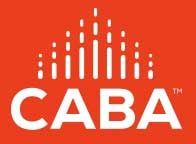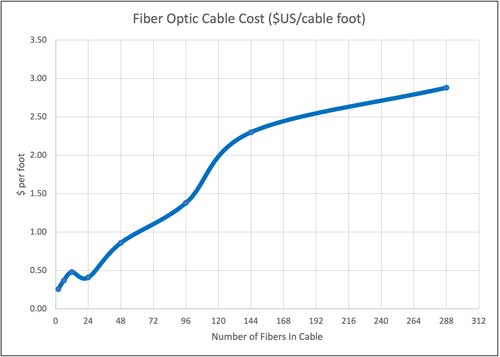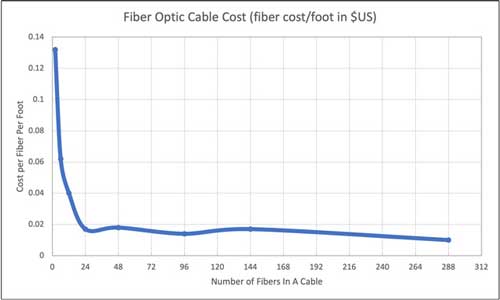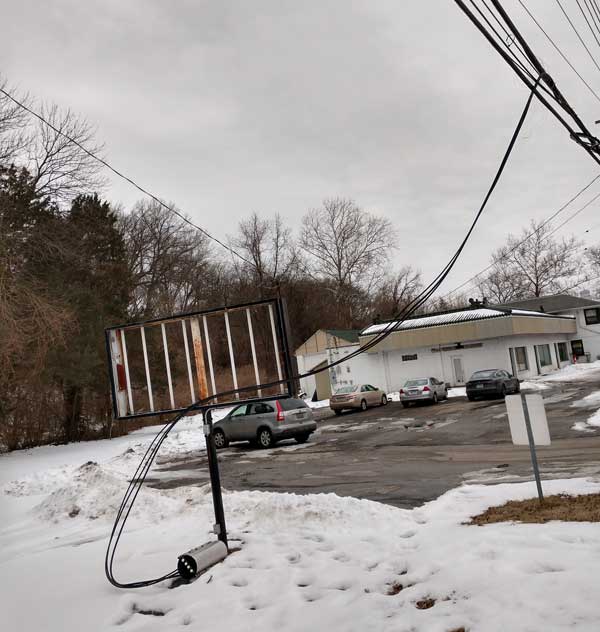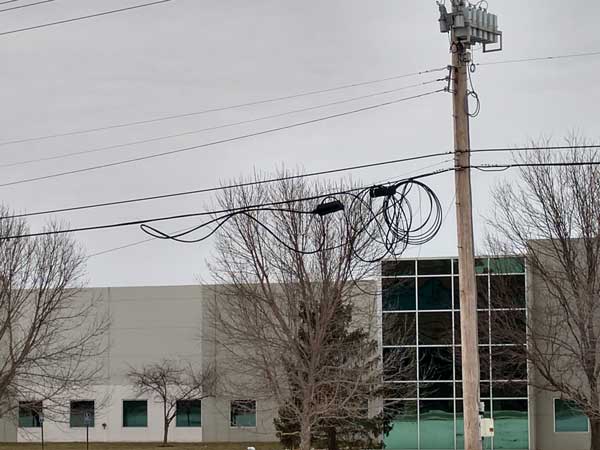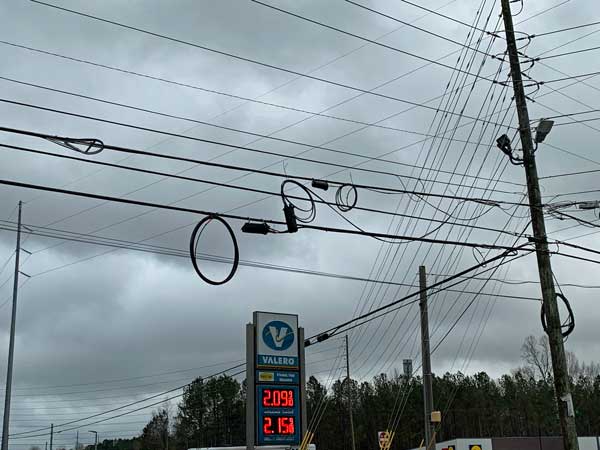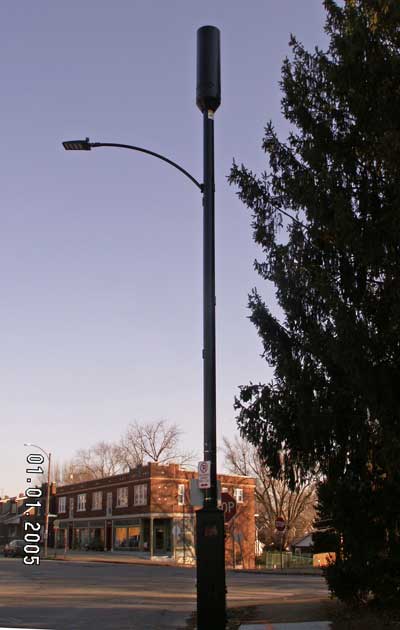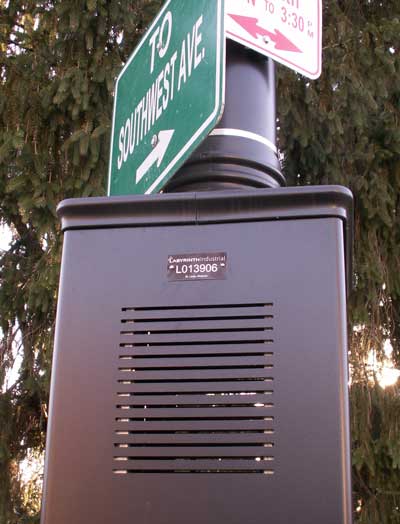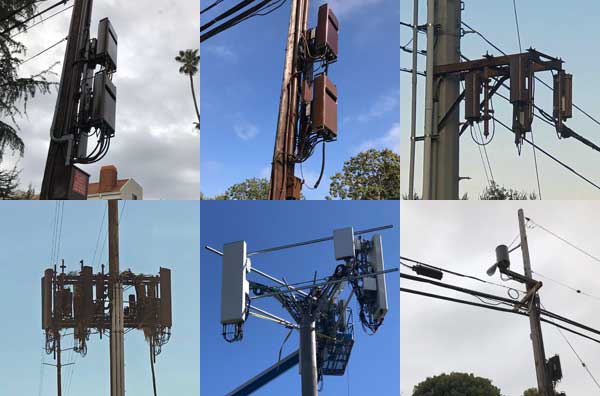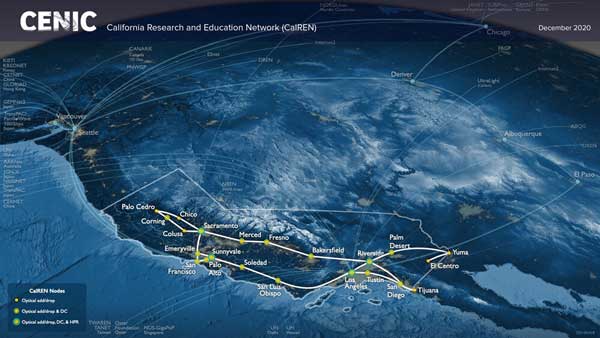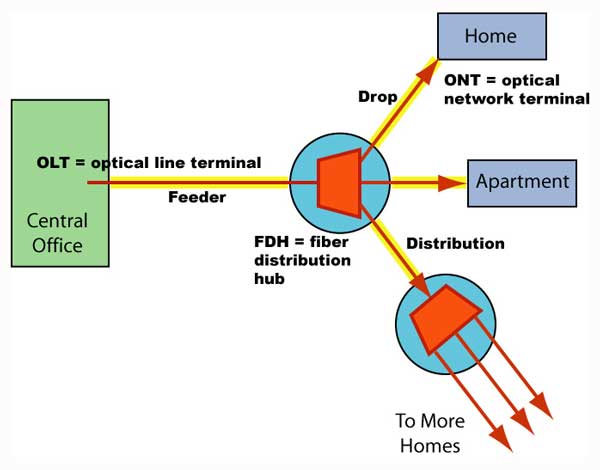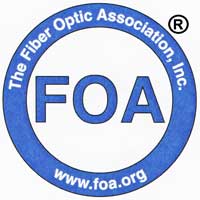
 March 2021 |
|||||||||||||||||||||||||
Search the FOA website FOA Home Page Contact Us |
Sign up for the FOA eMail Newsletter Privacy Policy Sections
News Technical Worth Reading Q&A Training/FiberU Resoures Safety About |
||||||||||||||||||||||||
FeaturesFiber For Rural BroadbandTapping Fiber To Save Fiber? What Is An Optimal Cable Size Why Fiber Techs Need Training Good Small Cell/Streetlight Design Where Are The Industrial Designers California's Educational Network Newsletter SectionsClick on any link to jump to that sectionNews Is It April 1st Already? OFC Goes Virtual Technical Taps For Rural FTTH? MM or SM FIber Continued, Loss Budget Calculator Worth Reading Lots of interesting articles Q&A Questions from our readers Training/FiberU New Fiber U MiniCourses, schools, remote OTDR for training, making training classroom safe, onine training, materials, more Resources New FOA YouTube Videos. Safety About FOA Certifications: 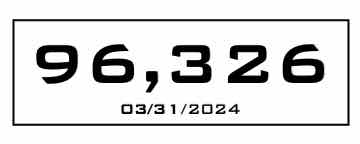 Special offer - 1/3 Off Renewal Jobs
Where Are The Jobs In Fiber Optics? FOA talks about all the applications for fiber optics, what jobs involve and the qualifications for the workers in the field in this YouTube video. Want to be notified when the FOA Newsletter is updated? Sign up for the FOA eMail Newsletter. You can also sign up from your cell phone: text "FOA" to 22828 (usual text message charges apply) Trademarks: The FOA CFOT® (Certified Fiber Optic Technician) and Fiber U® (the FOA online self-study program) are registered trademarks of the FOA.  Want to know more about fiber optics? Study for FOA certifications? Free Self-Study Programs are on "Fiber U®." Looking for specific information? Here's the largest technical reference on the web: The FOA Online Fiber Optic Reference Guide. 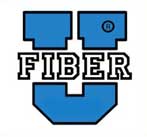 Free online self-study programs on many fiber optics and cabling topics are available at Fiber U, FOA's online web-based training website. FOA Reference Books Available Printed or eBooks The fiber book is available in Spanish and French 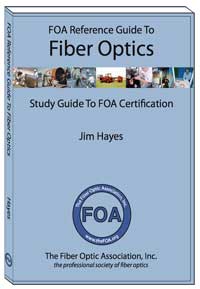
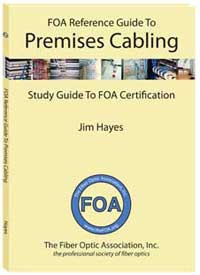
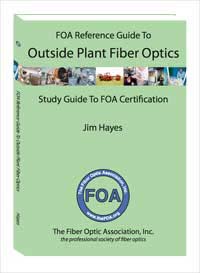
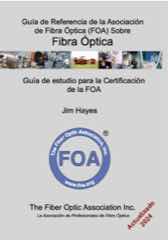 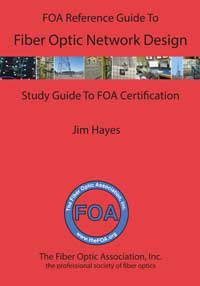
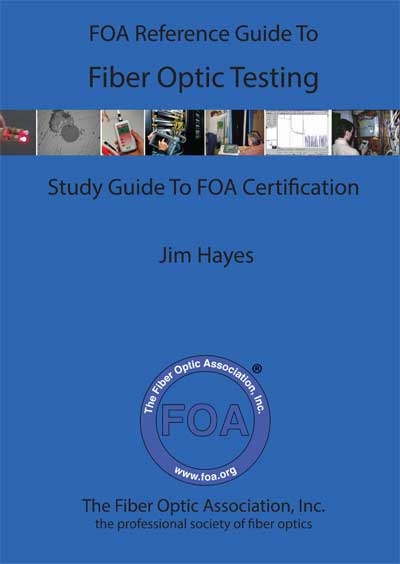
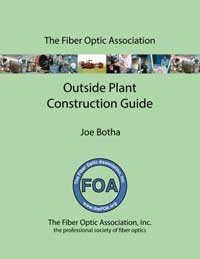
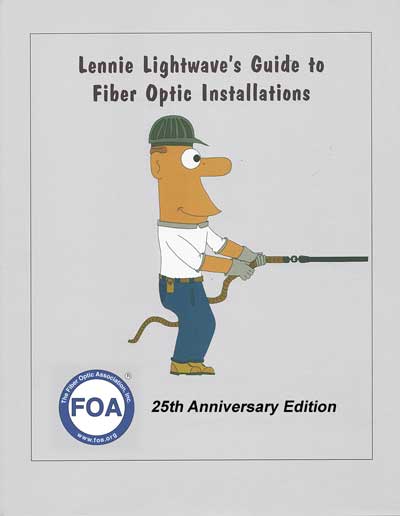 Lennie and Uncle Ted's Guides are now also available as free iBooks on iTunes. 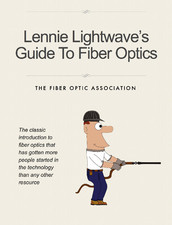
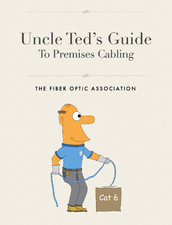 Click on any of the books to learn more.
FOA Videos on FOA is a member of: The FOA Newsletter is edited by Jim Hayes - send your stories, leads, ideas, comments to <jim @ foa.org>  Search the FOA Website With DuckDuckGo
1/13, 2/13, 3/13, 4/13, 5/13, 6/13, 7/13, 8/13, 9/13, 10/13, 11/13, 12/13 1/12 , 2/12, 3/12, 4/12, 6/12, 7/12, 8/12, 9/12, 10/12, 11/12, 12/12 1/11 , 2/11, 3/11, 4/11, 6/11, 7/11, 8/11, 9/11, 10/11, 11/11, 12/11, 1/10 , 2/10, 3/10, 4/10, 05/10, 07/10, 08/10, 09/10, 10/10, 11/10 1/09 , 2/09, 3/09, 04/09, 05/09, 07/09, 08/09, 09/09, 10/09, 11/09, 12/09 1/08 , 2/08, 3/08, 4/08, 5/08, 6/08, 7/08, 8/08, 09/08, 10/08, 11/08, 12/08 12/07 , 11/07, 10/07, 09/07, 08/07, 07/07, 06/07, 05/07, 04/07, 03/07, 2/07, 1/07 12/06 , 11/06, 10/06, 09/06, 8/06, 7/06, 6/06, 5/06, 4/06, 3/06, 2/06, 1/06, 12/05 ,11/05, 10/05, 09/05, 08/05, 07/05, 6/05, 5/05, 4/05, 2/05, 01/05, 12/04 , 10/04, 9/04, 8/04, 7/04, 6/04, 5/04, 4/04, 3/04, 1/04, 12/03 , 11/03 10/03 9/03, 8/03, 7/03, 6/03, 3/03, 10/02 , 8/02, 5/02 Current Issue of FOA Newsletter Time To Renew Your FOA Certifications?To keep your FOA certifications active, you need to renew them when they expire. Now we have a new more convenient way to renew - an online store at Paypal - where you can quickly and conveniently use your PayPal account or your credit card to renew your certifications.PayPal is available worldwide Join
FOA On Social Media
 FOA has four LinkedIn Groups FOA - official page on LinkedIn FOA - covers FOA, technology and jobs in the fiber optic marketplace FOA Fiber Optic Training - open to all, covers fiber optic technology and training topics Grupo de La Asociación de Fibra Óptica FOA (Español) SPECIAL OFFER - 1/3 Off Your Certification Renewal Cost In the near future, there will be a requirement for continuing education to renew your FOA certifications. FOA is testing an option for renewals where you take a short Fiber U online course.If you would like to help FOA test this option, you can save 1/3 the cost of your renewal. Go here to take the Fiber U CFOT Renewal Course: |
FOA Newsletter - FeaturesFiber
For Rural Broadband - "Solutions" Raise Issues
A
non-profit looking at rural broadband contacted FOA asking
questions about the issues of fiber for rural broadband. The
issues are well known; fiber can be expensive in rural areas
and wireless or satellites might be cheaper, but are they
capable of broadband speeds or as reliable as fiber? Our
discussions covered two topics not often discussed that can
reduce costs and extend coverage - using taps on the fiber
and optimizing the cable size. That resulted into some
interesting investigations into two ideas, using taps in a
fiber system and understanding cable costs. |
||||||||||||||||||||||||
|
|
Is It April 1st ALREADY? A number of recent news items made us wonder. What Standards Are Good For - Making You Hungry International Standard For Pizza Napoletana ‘Pizza Napoletana’ TSG is a round product baked in the oven with a variable diameter not exceeding 35 cm and a raised rim and the central part is garnished. The central part is 0,4 cm thick, with a tolerance of ± 10 %, and the rim is 1-2 cm thick. The overall pizza must be tender, elastic and easily foldable into four. ‘Pizza Napoletana’ TSG is distinguished by a raised rim, a golden colour characteristic of products baked in the oven, and a tenderness to touch and to taste; by a garnished centre dominated by the red of the tomatoes, perfectly mixed with oil and, depending on the ingredients used, the green of the oregano and the white of the garlic; by the white of the mozzarella slabs which are laid either closer together or further apart, and the green of the basil leaves, which are lighter or darker depending on the baking. The consistency of ‘Pizza Napoletana’ must be tender, elastic and easily foldable; the product is easy to cut; it has a characteristic, savoury taste given by the raised rim, which has a taste typical of bread which has risen and been baked well, mixed with the acidic flavour of the tomatoes and the aroma of the oregano, garlic and basil and the flavour of baked mozzarella. At the end of the baking process the pizza emits a characteristic aroma which is deliciously fragrant; the tomatoes, which have lost only their excess water, remain compact and solid; the ‘Mozzarella di Bufala Campana AOP’ or ‘Mozzarella STG’ are melted on the surface of the pizza; the basil, garlic and oregano develop an intense aroma and do not look burnt. In 2018, ANSI sent out a invite for interest in a standard for musical instruments. Are We Living In The Matrix? Are You Living In a Computer Simulation? Nick Bostrom. Philosophical Quarterly Is the move The Matrix for real? How do we know? It's generated a lot of discussion, prompting comments like this: "Thank you so much, Dr. Bostrom. You have proved that my psychiatrist was wrong all along." Give Your Network a "BOOST"  Sadly, the following is not a joke, but for real. It's simply an example of what American comedian/political observer Will Rogers said almost a centry ago: "America has the best politicians money can buy." Republican Broadband Agenda Would Preempt Local Authority and Ban Municipal Networks Last week, House Republicans introduced a bill package ostensibly to promote broadband expansion and competition across the country. In reality, the legislation is a wish list of monopoly cable and telephone companies that will protect them from competition and decrease their accountability to the public. It would also ban communities from building their own networks or engaging in public-private partnerships. ILSR Community Networks More Than 12 Million US Households Have Cut the Cord on Their Home's Broadband Service - Parks Associates: New research on the US broadband market estimates the US has more than 15 million households that have only mobile broadband service. This too is for real, but there is a reason: "High cost is the most prominent issue driving households to cut the cord and go mobile only, although service-related issues, from slow speeds to poor customer experience, also contribute," And Now Some REAL News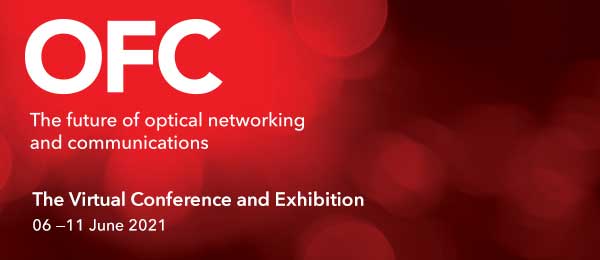 OFC, the biggest technical conference in fiber optics, will be virtual in 2021. |
||||||||||||||||||||||||
|
|
Tapping
Fiber To Reduce Cost - Is It Viable?
One
question asked was if there are FTTH architectures that are
cheaper than a traditional PON? They had read
a Commscope brochure that about using taps for rural
FTTH drops, saying it was cheaper than a regular design. |
||||||||||||||||||||||||
| Splitter Ratio | 1:2 | 1:4 | 1:8 | 1:16 | 1:32 |
| Ideal Loss / Port (dB) | 3 | 6 | 9 | 12 | 15 |
| Excess Loss (dB, max) | 1 | 1 | 2 | 3 | 4 |
| Typical Loss (dB) | 4 | 7 | 11 | 15 | 19 |
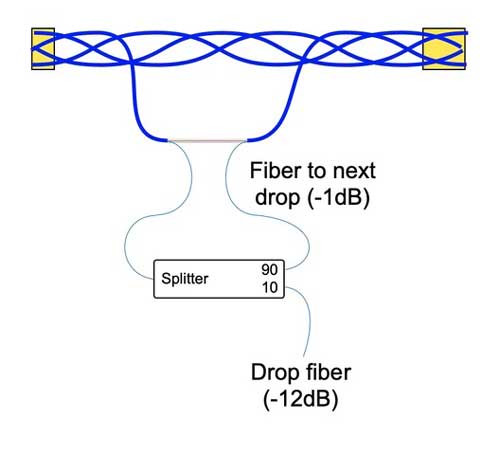
Tapping a fiber with midspan access
If the splitter is near the OLT, the drop fiber probably has enough power to allow a splitter to serve several subscribers, making it an efficient use of the tap and the fiber in the cable.
Determining if this is a favorable architecture for FTTH requires some careful analysis. Let's start with power budgets. If we have a 28dB power budget for GPON, downgraded to 25dB to allow 3dB margin, how many taps can we have?
Ignoring fiber losses, just considering the requirements at the subscriber ONT, we could have 13 drops maximum, since each tap loses 1dB, that would be a drop of 13dB plus the loss in the tap splitter of 12dB to the drop gives us 25dB loss at the last drop.
If fiber loss is 0.4dB/km, for each 2.5km of fiber, we lose 1dB and therefore must eliminate a tap. So if our length is 10km, we lose 4dB or 4 taps, so were down to 9 taps. 20km, we lose 8 taps so we are down to 5 taps or 5 subscribers total.
But remember we have 25dB or margin (with 3dB excess margin set aside for contingencies), so at our first tap we have extra margin so we could add another splitter to the tap and connect up more users, as many as 8 if the tap were close to the OLT or 4 even if the tap were 10km from the OLT.
There are many possible examples for this approach. Each network can be analyzed using the tap method to see if it is feasible. But the designer must not forget the total system cost evaluation which must consider the utilization of each OLT port as well as the use of the fibers in the cable.
Other Options
You don't necessarily need to use taps to reuse fibers after a splitter is used. Here is an example. At a junction you need to add a splitter for drops to a number of subscribers, so you insert a splitter. That terminates a fiber, leaving a downstream unused fiber. You can also add a 1X2 splitter that you need for drops later in the cable route and use that fiber, like this:
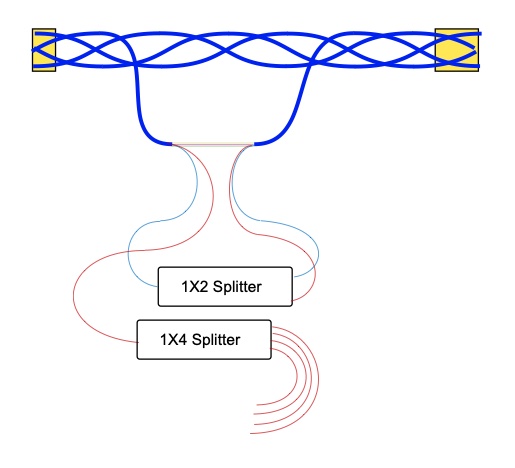
You could even use the downstream fiber to connect to one port of the splitter. There are many possibilitiies.
To make either a tap system or cascaded splitters system work requires carefully selecting split ratios, but to make it cost effective must also consider how to most efficiently use the OLT ports as well as the fibers available. And optimizing a network design to save the cost of some fiber, as we see in the analysis of cable costs in this newsletter, is not so simple either.
All this illustrates a simple truth; every installation is unique and there is no one way to design it.
Multimode or Singlemode Fiber? Update
Crosstalk A Problem In Fiber Optics?
Last month in the FOA Newsletter we looked at the continuing debate about whether one should choose singlemode or multimode fiber for new premises networks. OSP is almost exclusively singlemode, of course. We ran an article about Space Division Multiplexing (below) that used a modal multiplexing scheme where several signals can be multiplexed by transmitting them in separate modes in a multimode fiber. We were contacted by a reader about a problem that may exist with this technique - something that UTP copper has a problem with - crosstalk. If you get any mode mixing in the fiber, it appears as crosstalk and can affect transmission. Crosstalk may make this approach less successful.
You can read about crosstalk in Space Division Multiplexing in this paper.
Space Division Multiplexing
Another technique used to expand the bandwidth of MM fiber is called space division multiplexing. The "space" here is the core of the multimode fiber and the multiplexing uses separate modes to send different signals. It's like WDM where you have several signals at different wavelengths, but here it's separate modes. Considering the complexity of some multiplexing technologies in use today, this sounds simple.
One company, Cailabs in France, has developed this technology to a state they claim they can multiplex 45 signals in MM fiber and they offer products that have gained some customers. They have some very high profile customers so one assumes the technology works as described. But in an article in CI&M recently, they say they can use their technology to expand the bandwidth of MM fiber by transmitting a "singlemode" signal down the center of a legacy fiber. They say "A central-launch mode adapter can elicit from a multimode fiber a propagation similar to that of a singlemode fiber." But have they encountered legacy fibers with the central index dip that causes so many problems with the early applications of gigabit Ethernet?
A similar technique was used to send 1petabit/s data over multimode fiber using space-division multiplexing. Read the article in SciTechDaily.
Midspan
Access - Simplifying Installation Of Drops
Technical questions we get here at FOA often remind us of things many of us take for granted that are not known by many installers and particularly network owners and users. Recently we received an email like this from a network owner working with a contractor on a 15mile (25km) cable plant with roughly 17 locations where cable drops were needed. They were not aware of the technique of midspan access, so we created a new page for the FOA Guide on the subject (FOA Guide Page on Midspan Access), a YouTube video and a Fiber U MiniCourse.
Try The FOA's Online Loss Budget Calculator
FOA has written many articles about loss budgets, something everyone involved in fiber optics needs to know and needs to know how to calculate. We've created a online Loss Budget Calculator that does the work for you. Just input your cable plant data and it calculates the loss budget. It works on any device, especially smartphones and tablets for field use and even allows printing the results.
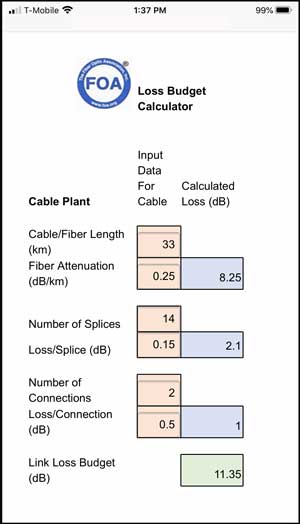
Bookmark this page (especially on your smartphone): FOA Loss Budget Calculator Online
Worth
Reading
Each month we read hundreds of newsletters and online articles. These are the ones we think you will find "worth reading."
Worth
Reading: 03/2021
Current
Map Of Undersea Fiber Optic Cables by
TeleGeography Five Fiber Outages Prove the Importance of Telecom Damage Prevention, dp-PRO magazine
"Who Lost Lucent?: The Decline of America's Telecom Equipment Industry"
This is a MUST READ for managers in telecom or any industry!
This long and well-researched and annotated article in American Affairs Journal should be mandatory reading for every high level manager in a telecom company - or any other company for that matter. To summarize the article, today, America has no major telecom equipment company and fears the major suppliers of equipment who are all foreign, especially the Huawei from China. This article explains how America got into this deplorable state.
Optical fiber for 1310nm single-mode and 850nm few-mode transmission a Corning invention that is not commercially available yet.
Tired Of Hearing About 5G? You Can Read About 6G Instead (Yes there is a group with a website already.)
Why Tuscon is building its own 4G network – Urgent Comm. “There’re a lot of people who think that the government does not have this responsibility,” Tucson’s CIO Boyce said, explaining that the city’s existing telecom providers Lumen Technologies and Cox have “spent a significant amount of time pushing back on this project.”
Connecting Carteret A PLAN FOR DIGITAL INCLUSION A North Carolina county evaluates its current situation and looks at the future. Good model for any government looking to survey its population.
Things You Should Know About IEEE Std 802.3cm™-2020; 400 Gb/s over Multimode Fiber. OFS - 400GBASE-SR4.2 is the first multimode standard to use two wavelengths (850nm and 910nm), enabling 100 Gb/s transmission over a single fiber pair. It also includes a new concept - using a single 400G port for 4 100G links, saving panel space on switches.
OFS also has an excellent website and blog of tech articles worth browsing.
California State Broadband Action Plan - California Broadband Council developed the “Broadband for All” Action Plan with the understanding that broadband access, adoption, and training are essential components of digital equity. Includes a detailed cost model.
More Than 12 Million US Households Have Cut the Cord on Their Home's Broadband Service - Parks Associates: New research on the US broadband market estimates the US has more than 15 million households that have only mobile broadband service. "High cost is the most prominent issue driving households to cut the cord and go mobile only, although service-related issues, from slow speeds to poor customer experience, also contribute,"
Federal money to SpaceX may hurt public broadband efforts in WA - Crosscut - Critics say money went to untested and unproven technology. Meanwhile, public agencies say it now will be harder for them to access broadband funding.
IEC 60050 - International Electrotechnical Vocabulary - An extensive dictionary for fiber optics in English and French. Highly technical - this is one definition: "mode - one solution of Maxwell's equations, representing an electromagnetic field in a certain space domain and belonging to a family of independent solutions defined by specified boundary conditions"
02/2021
Over
1 Million 400G Data Center Ports Shipped in 2020,
CI&M. And that is from one company, Innovium,
only, maker of Teralynx switches for data centers.
HyperOne Australian fiber backbone network planned Lightwave “HyperOne will be a new generation of hyperscaled network, capable of carrying over 10,000 Tbps – more traffic than every other national backbone built in Australia’s history combined,” according to the company's founder.
Recently
in ILSR's Community Networks Weekly Newsletter -
lots of interesting reading about communities and
broadband. Week
of 2/8/2021, 2/1/2021
1/25,2021
Thinking About Changing Jobs To Telecom? Use the Philadelphia Federal Reserve Bank's "Occupational Mobility Explorer" Scroll way down on the lists of occupations to find several options for telecommunications, like Telecommunications Line Installers and Repairers to see what skills are involved.
Recommendations for a National Broadband Agenda, Benton Institute for Broadband and Society - We need a national, comprehensive broadband strategy, a plan that ensures that everyone in America can use High-Performance Broadband as soon as possible.
Low-Earth Orbit Satellites: Great Idea but Not for Everything – And Not Cheap. By Steven S. Ross | Broadband Communities (And maybe as "loony" as baloons.?)
Statistics on US Labor In Telecom
Eric Pearson sent us some links to US Bureau of Labor Statistics data on the US Workforce. Granted it was updated in May 2019, but has lots of useful and interesting information on where the work is and what workers are paid.
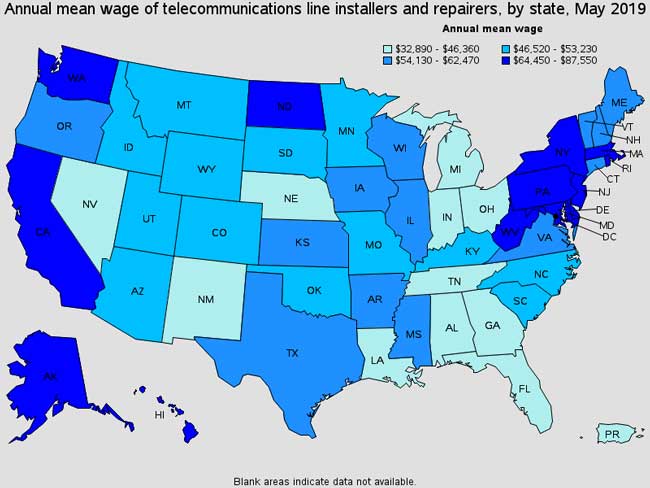
Read the reports here:
Telecommunications Line Installers and Repairers (Install and repair telecommunications cable, including fiber optics.
Telecommunications Equipment Installers and Repairers (Install, set up, rearrange, or remove switching, distribution, routing, and dialing equipment used in central offices or headends. Service or repair telephone, cable television, Internet, and other communications equipment on customers’ property. May install communications equipment or communications wiring in buildings.
01/2021
Making
Your Town Broadband Ready Even if you are not
ready to build your own fiber or FTTH network, there are
things you can do now to be ready when you make that
decision that will also help attract private investment.
This article is by Trevor Jones, Vice President of
Marketing, Sales and Customer service for OTELCO, which owns
independent telephone companies in seven states and partners
with several community networks in Massachusetts. Contact
him at trevor.jones@otelco.com. It offers good advice for
cities thinking about or needing fiber in their town.
(Broadband Communities)Removing Roadblocks on Bridge Over Digital Divide: Explaining the Affordable, Accessible Internet for All Act - Reversing laws that prohibited government or public/private broadband, mandating "Dig Once." ILSW Community Networks
Next Century Cities Year in Review - Overview of progress made in the last - eventful - year. Link is to a Black&White version which is easier to read. The color version is here.
Telcos’ tipping point: 10G Fiber and Software-Defined Access, Dell'Oro Group/Adtran. The need to provision and deliver new services in a matter of hours, as opposed to weeks or months, holds just as much priority as the ability to deliver up to 10Gbps of PON capacity.
12/2020
Dilbert's
Company Rolls Out 5G - DON"T MISS THIS!
Passive Optical LAN shines in Cost Comparison - Lightwave
Case
Studies - Next Century Cities - state of broadband in
some US cities.
Residents
Form Broadband Coop - “Electric
cooperatives worked, why can’t we do the same thing for
broadband?”

Saving Lives through Education. Online, worldwide April 6-8, 2021. The Excavation Safety Conference VIRTUAL brings critical damage prevention education to help all stakeholder groups online, providing new opportunities to network with industry peers, learn safe practices, and lower costs associated with underground damages. Register now at GlobalESCVirtual.com
1995-2020 - FOA's 25th Anniversary!
As part of celebrating 25 years of serving the fiber optic industry as its primary source of technical information and independent certifying body, FOA thought it appropriate to create a short history of the organization and how it has developed to help the fiber optic industry. We also wanted to recognize the contributions many people have made to the organization over the years that made FOA what it is today.The FOA history is now archived on the FOA website where you can read it anytime or link to it. Updated info - dB, total internal reflection and science projects,
Worth Reading - News Summary - Past Links Worth Repeating
Recycling Fiber Optic Cable - Contact:Steve Maginnis
LD4Recycle/ CommuniCom Recycling
(Visit website)
sm@LD4Recycle.com
803.371.5436
If you are interested in restoration - aren't we all? - you should also read this article in dpPro magazine by FOA President Jim Hayes: Damage Protection Requies Looking Overheas As Well As Underground - dpPRO Magazine - about the problems with aerial cables. His previous article for the magazine was New Techniques for Fiber Optic Installation.
How
much fiber optic cable is manufactured each year?
CRU Reports - unsurprisingly China is by far the largest
market today
The
Institute
for Local Self-Reliance weekly newsletter has
lots of interesting articles and links.
The Open Technology Institute at New America just
published “The
Cost of Connectivity 2020,”
US
Ignite and Altman Solon issued “Broadband
Models for Unserved and Underserved Communities”
Universal
access to broadband is a cornerstone to a strong
economy, Achieving universal access will require
community partnerships. by Alfreda
B. Norman, Sr. VP, Federal Reserve Bank of Dallas
FIBER
TO THE FARM: The co-ops that electrified
Depression-era farms are now building rural internet. Be
sure to check out the high-tech equine installation
equipment.
Next
Century Cities Newsletter - News from cities
around the US including Detroit and New York plus small
Infrastructure
Get Some Respect, NY TImes "On Tech"
"The magic of the internet requires a lot of very boring
stuff behind the scenes. "
Pentagon
official: FCC decision on 5G threatens GPS, national
security
Structured Cabling News - a website and weekly newsletter about cabling.
The Internet Master Plan for New York City. The New York City Internet Master Plan is a comprehensive framework for the infrastructure and services that provide connectivity to New York City residents and businesses. This Master Plan will guide City actions and public-private partnerships to transform New Yorkers’ access to this essential infrastructure for generations to come.
Fiber Trivia From Corning.
Why understanding PoE now is crucial for electricians - To ring in the new decade, IDEAL Networks is urging today's electricians to master new skills and equipment to cope with the growing use of PoE in intelligent lighting applications.
Smart City Projects: Smart city initiatives are underway across the country. But they face funding and technology challenges. Many cities want to upgrade infrastructure to improve resident experience, safety and to generate revenue.
The Future Of Work Is Skills - So Stop Worrying About Degrees - The reality is the future of work is about skills, not just degrees. (FOA Newsletter Feb 2020)
Want
a White-Collar Career Without College Debt? Become an
Apprentice (NYTimes)
Apprenticeships probably began with the first jobs, where
young people work under experienced craftspeople to learn
a trade. In the last century, they became more organized
under labor unions like the International Brotherhood of
Electrical Workers, one of the FOA's oldest and biggest
approved school systems. Today, apprenticeships are
expanding as young people look at viable alternatives to
loading themselves with debt while attending college.
The
job market is hot. So why are half of U.S. grads
missing out?
VIAVI Books On Fiber Optic Testing (2 volumes) - They're back!
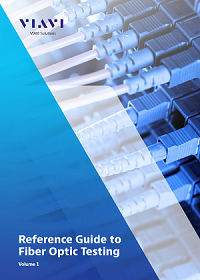
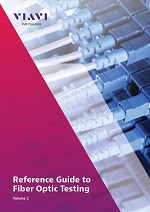
Besides the FOA reference materials, two JDSU/VIAVI textbooks, Reference Guide to Fiber Optic Testing, Volumes 1 and 2, were used as references for some of the FOA courses and are recommended for instructors and students. The books are available from VIAVI as eBooks and the everyone should download them and recommend them to others.Download yours now. Volume 1. Volume 2. Viavi Books
Guidebook To MPO Testing OptoTest offers this complete guide to MTP®/MPO testing. In this guide, you will learn all there is to know about the different test methods, equipment options, troubleshooting, and best maintenance practices to ensure that you have the best testing experience. Go here to download the book.
50th Anniversary of The Development of Low Loss Fibers A history of the development of low loss fiber, a fascinating story by Jeff Hecht on the OSA (Optical Society of America) website.
How OFS Makes Fiber
Interesting YouTube video on how fiber is made. Perhaps a little too much "show biz" but fascinating. If you have ever seen fiber manufacture, look at this video. You will be amazed at how big preforms have become!
How Nexans Makes Copper Cables - compare the process to fiber - don't most of the machines look similar?
The True Cost of Telco Damages (what backhoe fade or target practice can cost)
Rural Electric Cooperatives: Pole Attachment Policies and Issues, June 2019.
Clearfield-FOA Certification Training Clearfield is now offering their customers an FOA CERTIFICATION course. This course provides a basic understanding of fiber optic technology, as well as Clearfield product knowledge and how Clearfield’s integrated product systems work together in a fiber network.
Substandard Contractors - Fiber Optic Knowledge Doesn't Always Trickle Down (EC Mag)
Another Source Of Articles On Fiber
FOA President and editor of this newsletter Jim Hayes has also been writing a column in Electrical Contractor Magazine for almost 20 years now. Electrical contractors do lots of fiber work and this column has covered some topics they are interested in including installation processes, network design, fiber applications and a lengthy series on dark fiber - what it is, how's its used and how it benefits the growth of communication. A recent web site redesign makes it easier to browse all these articles - just go to http://www.ecmag.com/contributing-authors/jim-hayes and you can see all of them.
Q&A
Tech Questions/Comments From FOA Newsletter Readers Worth Repeating
The FOA Fiber FAQs Page (FAQs = frequently asked questions) gathers up questions readers have asked us (which first ran in this newsletter) and adds tech topics of general interest.
Good
Question!
The FOA Fiber FAQs Page (FAQ s = frequently asked questions) gathers up questions readers have asked us and adds tech topics of general interest.
Questions From FOA Newsletter ReadersFebruary 2021
Documenting Test Results
Q: We’re currently working on a bid that includes presenting some test sheet documentation for OTDR & Light loss testing. What should I do?
A: High end LSPM or OLTS should store data and have some software to report test results. Simpler units should simply require logging data into a spreadsheet showing Cable ID, Fiber ID, wavelength and loss. Details like launch & receive cables and test results can be kept separately on the spreadsheet. Today’s OTDRs will show you a trace and an event table that lists each even in the fiber tested as well as overall loss. Whatever OTDR you use should have software for reporting test results. Here is an example of a report from an EXFO and a trace from a Yokogawa.
Installing Cable
Q: Below are specs for an installation. We’ve never installed a Fiber Optic run this long. Please see below questions and info.
-Fiber Optic cable to be used is a 24 strand Single Mode application
-Length of run is 7200 m long
-Appears that all the Fiber is on one reel. However do you recommend having some junction points on pedestals along the way for testing-maintenance purposes or just one continuous run if possible?
A: FOA has lots of information to help answer your questions:
Re underground installation. See https://foa.org/tech/ref/OSP_Construction/Underground_Construction.html and https://foa.org/tech/ref/OSP_Construction/Underground_Installation.html in the FOA Guide.
There are other questions you need to ask:
Are there no intermediate connections or drops required? It’s just one straight fiber run? You should be able to install it continuously.
What is the installation type? Pulled in conduit or direct burial?
If pulled in conduit and you can pull in one try, that’s best. You should use a pulling capstan to limit tension, attached to the cable with a breakaway swivel pulling eye and use lubrication. Use the American Polywater guides (https://www.polywater.com/product/polywater-f-fiber-optic-pulling-lubricant/) for choosing lubricant and decide if you need an intermediate pull.
Direct burial is simple for a long run, just ensure you have the proper equipment.
January 2021
Maintaining Dark Fiber
Q: Do you have any standards that speak to how often dark fiber should be tested with OLTS and OTDR? Such as just at installation and when troubleshooting, or should they be done on a regular basis?
A: We at FOA know of no standards calling for periodic testing of fiber optic cable plants.
Fiber optic networks generally do not require maintenance and it is often detrimental to the network. It is the opinion of FOA and most people in the industry that testing should be done upon completion of the installation and data submitted to confirm proper installation of the cable plant. Data should then be stored for reference in case of problems requiring troubleshooting or when new dark fibers are turned up. Before lighting a dark fiber, it should be tested and the results compared to earlier data. Since both tests have some uncertainty, test results can vary as much as 0.5dB on short cables, higher on longer runs.
If older fiber is being upgraded to higher speeds, now cities like Santa Monica where we live are upgrading to 100G networks, fiber characterization including chromatic dispersion, polarization mode dispersion and spectral attenuation (for DWDM) are advised. Of course, every time a connection is opened, it should be inspected and cleaned. And patchcords should be tested; even new ones in sealed packages are often dirty. There is a reason people call the plastic protective caps on connectors “dust caps!”
Otherwise, with fiber, we suggest the patch panels be locket to keep unauthorized personnel from accessing them and causing problems. Even disconnecting a connector can add dirt to the connections and cause problems.
December 2020
Are FOA Videos and Web Up To Date?
Q: Are the videos on YouTube still relevant by today's standards are are they out of date?
A: Excellent question. We’ve discussed this within the FOA many times.
For example the live action videos on cable preparation, termination, mechanical and fusion splicing and testing are quite old by tech standards but the processes have not changed in two decades. Preparing loose tube, armored or tight buffer cables has not changed in over 20 years, nor has adhesive/polish connector termination. Prepolished/splice connector and SOC process are different and those processes have been updated. Testing processes are the same with the main difference being the automating of OTDR testing. Manufacturers have dumbed-down OTDRs so well that it seems few techs know how they work or how to read a trace, evidenced by the results of the FOA CFOT Certification exam where questions on OTDRs are the most often missed.
We just did a review of the copper installation for the Premises cabling (CPCT Certification) and that has not really changed in three decades - since the introduction of Cat 5 cable!
We review and update the technical pages in the FOA Guide all the time. Look at the Table of Contents (FOA Guide-https://foa.org/tech/ref/contents.html) and see how many pages have the NEW symbol, indicating updates in the last couple of months.
Also FOA is adding YouTube videos (https://foa.org/tech/ref/contents.html#YT ) and Fiber U MiniCourses (https://fiberu.org) on many topics regularly - monthly this year, covering new tech and the topics we know are lesser-known or new to most techs.
And let us know if there are topics you think we should focus on in the future.
Microscope Power For Connector Inspection
Q: What power microscope do you recommend to inspect singlemode/multimode in 1.25/2.5 format (ST, SC, LC)?
A: Microscopes in the range of 100-400 power are available. Many people assume higher power is best - and it is for examining polishing results in the center of the ferrule - but lower power helps inspect more of the ferrule for dirt when used in the field before connecting or testing cables. We prefer the lower power.
So for patchcord manufacturers, 400, field techs 100. Patchcord manufacturers will undoubtedly use video microscopes, most field tech the optical ones.
November 2020
Loss For APC vs UPC Connectors
Q: I was wondering if there will be a standard connector loss for a UPC connector and a different lower value for an APC connector.. ex. upc has 0.5dB while APC is 0.3dB.
I would like to make all connectors uniform on a new network infra to avoid mismatch and causing any possible damage on the equipment when APC will be plugged into to a flat.
A: There is really no statistical difference between APC and UPC connector loss. The lower reflectance of the APC actually reduces loss since the reflectance represents a factor in connection loss, This issue of connector grades has been discussed at international standards committees for years. ISO/IEC wants to have grades of connectors, rated for connector loss in ranges from 0.1 to 1dB, but I do not think it’s standardized. I recommend using 0.3-0.5dB for loss budgets, where in OSP networks it matters little, since there are only a few connections and fiber and splice loss is a larger factor.
Keeping UPC and APC connectors straight is easy - APCs are Green, UPCs are blue. Everybody just needs to be taught that!
OTDRs - Launch Cables And Range
Q: I have a question about OTDR launch cables. In all readings about OTDR testing, it states that the launch cable "needs to be of sufficient length ...". What length is sufficient? How long should a launch cable be? What is the maximum length of cable plant that can be tested at one time?
A: OTDR launch cables need to be long enough to allow the OTDR to settle down after the test pulse leaves the instrument and reflectance at the output connector overloads the receiver. The dead zone is a function of the OTDR test pulse and the condition of the output connector. If you are testing short cables (<1km) with very short test pulses, a launch cable can be 20-50m long. If you are testing a very long cable with very wide pulses (some OTDRs have pulses ~4microseconds long, equivalent to ~1km) you would need a 2-5km launch cable. So the answer to that question is it depends on how long the fibers are you are testing.
As to how far a OTDR can reach, the answer is generally not specified in km but in dB. The best OTDRs have a reach of ~40dB at 1550nm which corresponds to ~150-200km, spending on how good the splices are. That length of fiber would have ~30 splices for say 3dB splice loss.
Here’s the FOA Guide page on OTDR testing and the FAQs page Frequently Asked Questions about OTDRs.
October 2020
Last month's article about the installation of a 6912 fiber cable in small conduit prompted a number of this month's questions on social media. And there were more too.
Re: Installation of a 6912 fiber cable
Q: For this post, "Tight Fit: 6912 Fiber Cable Pulled in 1.25 inch Conduit”, he asks if they can see one end completely terminated?
A: It takes about 2 full racks of patch panels or one rack of splice trays. Sumitomo shows the splicing rack here https://global-sei.com/data-center-solutions/splicing-rack.html. Most systems using these cables will buy fully populated patch panel racks with a splice rack for the cable to splice to 6912 fibers terminated in the rack.
Q: And a second question:: How long does it take to terminate? And over how many panels?
A: A very experienced tech can splice one of these cables in ~75-100 hours using ribbon splicing.
Q: I assume that's smaller fiber like 80 micron cladding
A: All the fibers in the high fiber count cables are made with regular singlemode fiber - 9/125micron. TO make the cables smaller, the buffer coating diameter is reduced to ~200microns to make the fibers smaller.
Q: How was it prepared with the splice tray and ODF? It might require a dedicated panel and splice tray.
A: It takes about 2 full racks of patch panels or one rack of splice trays. Most systems using these cables will buy fully populated patch panel racks with a splice rack for the cable to splice to 6912 fibers terminated in the rack.
Q: Is this an actual photo or was the cable installed in a different type conduit.
A: We were told that is the actual size of the cable and conduit although not of the actual installation discussed.
Q: What is the minimum bend radius of that cable? What procedures did they use to maintain that bend radius through those 90 degree curves?
A: The minimum bend radius is 15X the cable diameter for that cable (diameter 1.14” or 29mm), about 17” or 435mm. The conduit bends had to be controlled to be larger than that radius.
Jobs In The Movie Industry
Q: Does anyone know if there are job positions in the film industry that involve fiber optics? I started out working in film with audio work with some camera as well. I eventually transitioned into fiber optics installation and testing. I've been trying to find out if there's a way to find work that combines the two.
A: There are certainly jobs for fiber techs at the film studios. We worked with a group 20 years ago to find dark fiber in LA to connect studios to sound stages and other facilities. Every studio now has fiber connections everywhere, like this one at Paramount (below). I don’t know where to look for jobs, but I’d guess it would be through the unions - who represents the techs for the cameras, monitors, etc.?
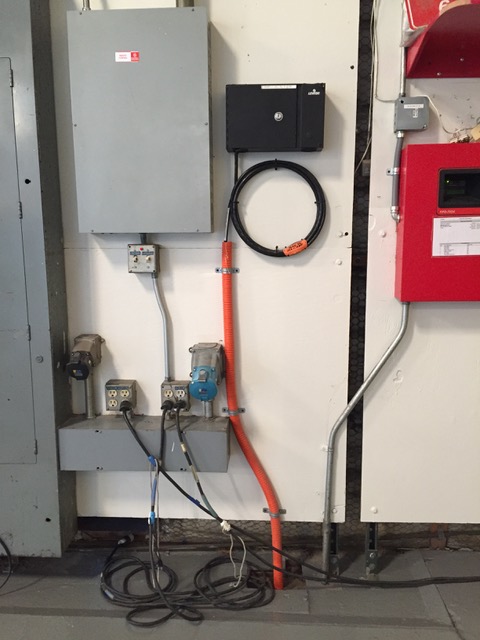
Preparing Cable For Splicing
Q: Is there any standard on the preparation length of strip jacket upto the splice tray. Ideally its better to have a loop of buffer before getting into the tray if ever the closure has enough space for slack.. its also nice to put some hose to the buffer to add on protection. So far, i don't see any standard and can't support the remarks on what to follow. The practice was to take note on macrobend and have enough length of fiber to reach the machine.
A: There is a lot of variation in the size, shape and design of splice closures, so the length varies according to the closure and trays. For loose tube cable, the length of buffer tube from the entrance to the splice tray and the length of fiber needed in the tray are given in the directions for that splice tray. Similarly for ribbon cable, but the variations in ribbon cable designs often requires special handling and sleeving for the ribbons. Most manufacturers have specs available online.
Fusion Splice-On Connectors (SOCs) (From an FOA Instructor)
Q: A question came up from one of our students regarding splice on connectors. Is there a TIA or other standards body that addresses this issue? We are used to the 0.75 dB loss for a mated pair, however, when this mated pair has two fusion splices that terminate the connector, is there a recommendation?
One could make the argument that it does not make any difference as the other alternative is splicing a pigtail for termination of a cable. This pigtail splice is normally included in the link loss budget calculation. So similarly, with a splice on connector it is the same as splicing on a pigtail.
A: There are no specific TIA or IEC specs that address these splice-on connectors or pigtails. If you used TIA numbers and included the splice and connector it would be 1.05dB - 0.75dB for the connection and 0.3dB for the splice, that’s mated to a factory adhesive/polish connector. Or if it were two similar connectors, 1.35dB.
Everybody, including the people in TIA standards groups, know those numbers are too high for most single ferrule connectors. They keep them at 0.75dB for prepolished/splice connectors (w/ mechanical splices) and array connectors (MPOs) which have somewhat unpredictable performance. Internationally, IEC has created grades of connectors from ~0.3 to over 1dB. The newer mechanical splice connector kits now use the Chinese copied cleavers which are super - at least the few we have tested - and the connectors are now much lower loss and consistent.
SOCs (fusion splice-on connectors) are spec’ed as the total termination and are generally just as good as the typical adhesive polish connector - 0.5dB is plenty of margin for a those mated to a factory adhesive/polish connector.
Spliced on pigtails are generally considered a termination and the splice is not broken out - like a long SOC. But I cannot guarantee everybody thinks that way. But a fusion splice is typically <0.1dB anyway.

The word on the "Dig Once" program is getting out - FOA is getting calls from cities asking us for information and advice. Here are some links:
The DoT page on the administration’s Executive Order: http://www.fhwa.dot.gov/policy/otps/exeorder.cfm
From the Council of State governments: http://www.csg.org/pubs/capitolideas/enews/cs41_1.aspx
From the city of San Francisco: http://sfgov.org/dt/dig-once
An article about Dakota County, MN: https://muninetworks.org/tags/tags/dig-once
And the one to download and hand out:
A “How To” Guide from The Global Connect Initiative: https://share.america.gov/wp-content/uploads/2016/04/6.-GCI-Dig-Once.pdf
Fiber Optic Cable Plant - The Finished Product 4/2020
In April, FOA received inquiries from several sources that all deal with the same subject - what is involved in the specification and acceptance of a cable plant at the end of a installation project. And what are reasonable specifications for a cable plant.
FOA has a lot of documentation on a project involving designing and installing a cable plant in the FOA Online Guide and our Textbooks, but the acceptance process has usually been relegated to a few paragraphs. We decided to add a page on project "Deliverables" in the FOA Guide that covers this topic in more depth. This page looks at a project, goes into some depth on loss budgets and includes links to FOA tech documents to help you investigate further.
Correction: In the article, the original list of fiber specs for G.652 was wrong. It should be 0.4dB/km @ 1310nm.
Deliverables in the FOA Guide
Is There A Standard For Fiber Optic Installation?
Another question we get often is "Is there a standard for fiber optic installation." The answer is yes, but not from the usual standards groups you might expect. Over 20 years ago, the National Electrical Contractors Association (NECA) asked FOA to help create a standard for installation. That standard, ANSI/NECA/FOA-301 has been updated three times already and is about ready for another update.
Unlike most of those groups who charge you a fortune for standards, FOA covers the cost so ANSI/NECA/FOA-301 is available free from FOA.
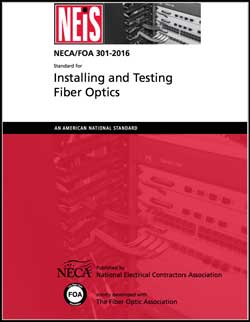
Download your free copy of ANSI/NECA/FOA-301 here (PDF)
Older questions are now available here.
Training / FiberU
News and resources to help you learn more and stay updated.
Find a listing of all the FOA-Approved schools here.

Free online self-study programs on many fiber optics and cabling topics are available at Fiber U, FOA's online web-based training website.
Free online training at Fiber U
The FOA has >100 videos on

More
New Free Fiber U MiniCourses
How Fiber Works
Another of the mysteries of fiber optics, like dB, is how optical fiber actually guides light in the core of the fiber and transmits it with low loss. FOA has several pages in the FOA Guide on how fiber works with animated graphics that illustrate the different ways step index multimode, graded index multimode and singlemode fiber work. We also have YouTUbe video showing live demonstrations with a large plastic rod simulating the core of an optical fiber.
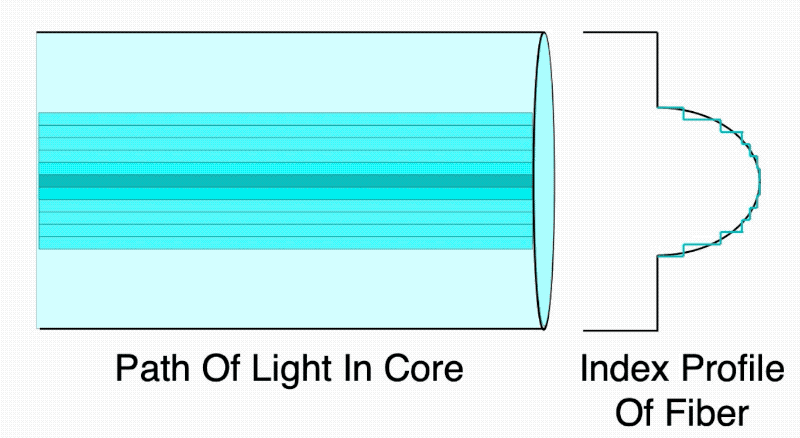
When we decides this was a good topic for a Fiber U MiniCourse. we decided to create a new video lecture on how fiber works. The lecture uses our usual lecture format but with videos that animate the process of total internal reflection and guided rays (modes) in the cores of the three types of optical fiber.
How Optical Fiber Works - Fiber U MiniCourse
Reading OTDR Traces
The second course this month covers one of the topics most missed on CFOT certification exams - Reading OTDR Traces. It's all about what elements are displayed in an OTDR trace and what they represent. It's a very different format from other Fiber U courses. OTDR traces are visual, so it's a visual course where you learn by "pointing and clicking" on a simulated OTDR trace, like this:
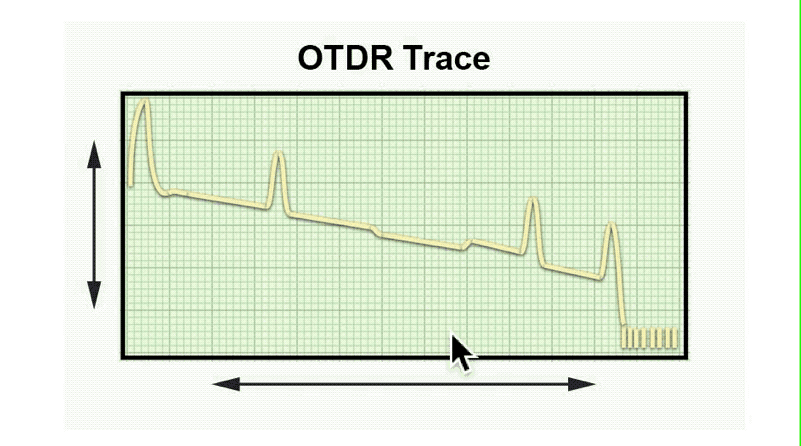
Midspan Access
As promised last month in our tech article on midspan access, we took the new material created about Midspan Access in fiber optic cable installation and made that into a minicourse. This technique is fairly widely used because it saves much time and cost in adding drops to a fiber optic cable, but we've been surprised how many techs are not familiar with it. The MiniCourse takes only a little time, about right for a coffee break.
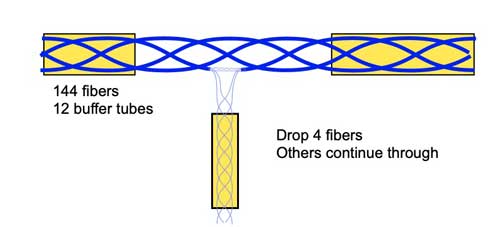
That makes 10 Fiber U MiniCourses, 5 Basics courses, 4 Skills courses, 1 Design course and 6 Applications courses - 26 free online self-study courses for everyone. And we have lots more planned for the near future.
All Fiber U courses are free but there is a nominal charge for the tests for a Certificate of Completion to cover the cost of the online testing site we use. Most online courses cost hundreds or thousands of $US, so we are sometimes asked how FOA can offer free courses. The answer is we have very low course development costs since we use the FOA Guide's pages (almost 1,000 of them) and Videos (over 100 on YouTube) and the courses are completely self-study - no instructor to guide you and provide feedback on your work. (And we do not track you.)
The Fiber U course method has been around for over two decades and used by tens of thousands of people to learn more about aspects of fiber optics or prepare for their FOA certification exams. Since the reference material for Fiber U is the same as used for training for FOA certifications and for the certification exams themselves, Fiber U courses are the ideal study guide for FOA certifications.
More
New Fiber U MiniCourses
Got An Hour Or Less? Learn Something New About Fiber Optics.
FOA has introduced a new type of Fiber U course, the MiniCourse, a free online course you could take in a short time, perhaps as you ate lunch at your desk or took a coffee break. The topics of these courses should explain what they are about, and these are all very important topics to fiber optic techs.
Fiber Optics In Communications
How Optical Fiber Works
Fiber Optic Network Restoration
Fiber Optic Connector Identification
The Mysterious dB of Fiber Optics
Fiber Optic Cable Bend Radius
Fiber Optic Link Loss And Power Budgets
Fiber Optic Connector Inspection And Cleaning
Fiber Optic Media Conversion
Fiber Optic Cable Midspan Access
Reading An OTDR Trace
The courses have two components, video lectures and readings, that are complementary. As usual there is a self-test to allow you to check your comprehension. As with other Fiber U courses if you desire, you can take a short test for a Fiber U Certificate of Completion that costs only $10.
All these free courses and many more are available at Fiber U.
New FOA Schools
Welcome
School
386 Peabody HS (program in conjunction with RCN)
What
Fiber Techs Don't Know -
What We Learn From FOA Certification Tests
As FOA moves more testing over to our digital online testing system at ClassMarker, we have access to more data about our testing, including what questions and topics on the tests are answered incorrectly most often. Having this data gives us an opportunity to evaluate the questions and how they are stated, but more importantly it allow us to help our instructors teach the subjects and us to change our curriculum and online courses to emphasize these particular topics. These are some of the topics that we have noticed are answered incorrectly more often in FOA and Fiber U tests.
Most of the questions missed are on testing.
1. OTDRs - particularly what information is in the OTDR trace.
2. The difference between dB and dBm
3. Loss budgets - both the concepts and doing the math
4. Insertion loss testing - single-ended or double ended for testing patchcords or cable plants, how to set 0dB references
5. Units of measure - fiber is measured in microns, wavelengths in nanometers, etc.
At FOA, we're working to add Fiber U MiniCourses on these topics and working with our schools to emphasize these topics in their classes.
If you are going to be taking a FOA certification course or test in the near future, these topics should be on your final exam study list.
What We Learn From Hands On Labs
We learn about students performance in hands-on labs from the feedback of our instructors and our own experiences too. One big problem is the use of hand tools. Growing up today, you learn how to use keyboards, mouses and touch screens, but decades ago, you also learned how to use basic hand tools. This is big enough of a problem that we're considering adding some video lessons on basic hand tools to prepare students for cable prep, termination and splicing that require the use of hand tools.
FOA
"Work-To-Cert" Program
Experience Plus Online Study At Fiber U = FOA Certification
This year, more techs have become comfortable with online conferences, webinars and training. Many have discovered that they can become FOA Certified using their experience in fiber optics and study for the FOA certification exams online at Fiber U. Thousands of industry professionals have applied to the FOA directly for certification without the need for classroom training, based on their knowledge and skills developed working the field. Since FOA certifications are based on KSAs (knowledge, skills and abilities), current techs already show the skills and abilities required through their field experience. FOA provides free online self-study courses at Fiber U for the knowledge part to prepare you for FOA certification exams which you can also take online.
If you are an experienced field tech interested in certification, and FOA is the internationally recognized certifying body for fiber optics, you can find out more about the FOA "Work to Cert" program here.
If you are already a CFOT, FOA also offers many specialist certifications you can obtain based on your experience as a field tech. See what's available at Fiber U.
Options
For Training Classes -
Social Distancing and Masks
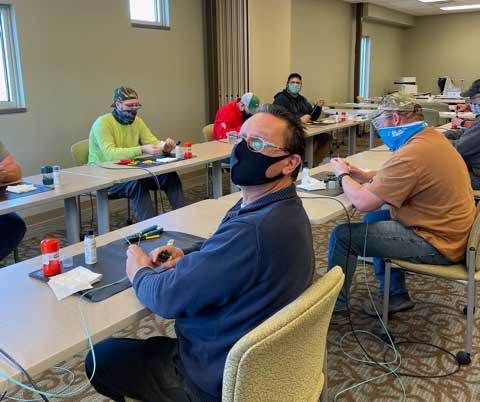
Outdoors
(11/2020)
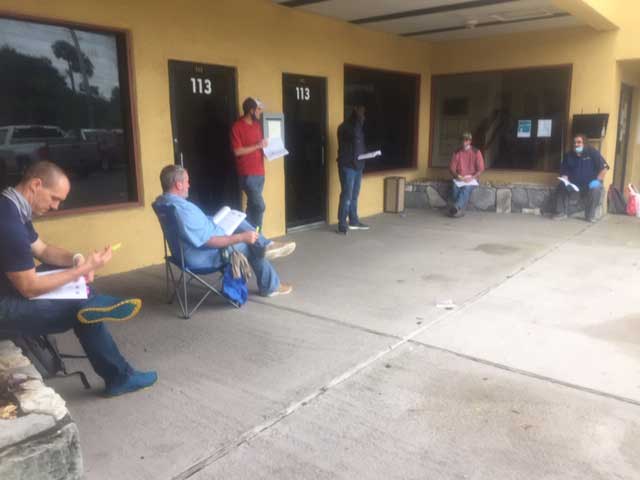
Tom Collins, Techtricians, FOA Director, keeps exploring new ideas for training. This time, the course moved outdoors in Daytona Beach, Florida. This solution works well as long as it's warm and dry!
New
Approach To Fiber Optic Labs - Sharing Test Equipment
(10/2020)
Tom
Collins, Techtricians, FOA DirectorTechtricians, a FOA approved school, has taken a new approach in how we provide lab training. Fifteen years ago, we developed a hybrid training model had the participants complete online (remote) lessons with face to face labs. Over the past 12 years trade organizations, colleges, vocational, vendor training, and trade apprenticeships have adopted this model. At the beginning of the pandemic we spent a lot of time, energy, and money developing remote labs. We have incorporated lessons learned from that process to restart safe face to face labs.
First, we provide disposable materials and PPE’s for all learning. Every student has their own work space with 8-9 feet of separation and their own set of hand tools only used by the student. All of the classroom information is accessed online or with USB drives. Our biggest challenge was how to safely share testing equipment so every student could have the practical hands on experience.
We believe we have found that solution with the help of “ezremote”. The ezremote allows a multitude of students to have practical exposure and experience with using a video microscope, OLTS and OTDR testers. Every student can access the remote via their own iPad or their smart phone, see below picture and movie.
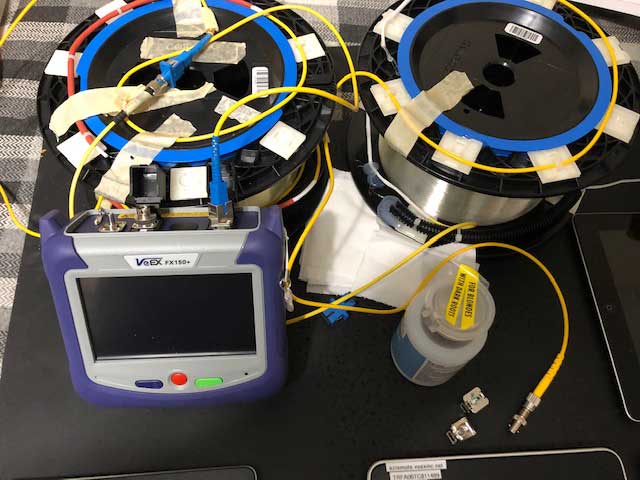
The VeEX OTDR set up for remote access in class
Recently, we contacted PCS, Inc. which is a premiere manufacturer’s representative firm serving the Southeastern US since 1974. Headquartered in Roswell, GA, Marc Wright a sales representative spent a lot of time and energy helping Techtricians to purchase the VeEX FX150+ device. It is a full featured Mini OTDR with high resolution sampling and intelligent link mapping for Metro, Access and FTTx networks remote application. The compact, lightweight platform incorporates built in WiFi, power meter, light source, fiber inspection probe and VFL test options which add exceptional versatility to the unit.
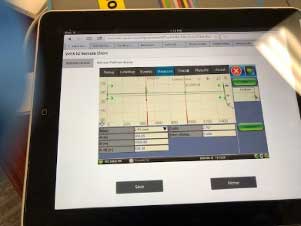
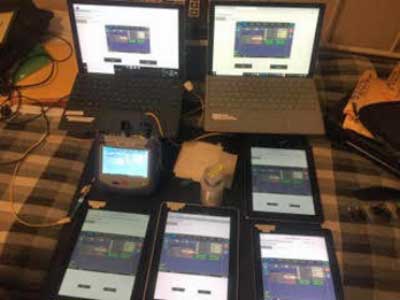
The remote OTDR displayed on an iPad (L) and on 4 smartphones and 2 laptops
In September we completed our first trial in a face to face lab session in Lake Mary, Florida. The OTDR unit uses a WIFI connection. The students went to the VeEX website with their iPad or their smart phone and connected the to the base unit. The lab module used one OTDR setup for the entire class for testing the cable plant.
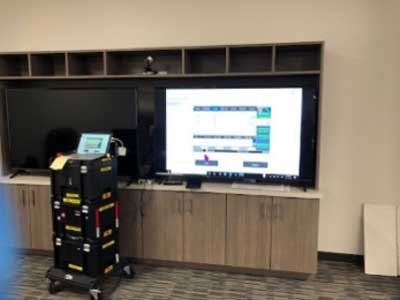
The instructor's laptop is connected to the OTDR and projecting the display for everyone to see
The students when logged-in had control over the OTDR. Each student saw the same screen which made the various events much easier to explain. The module is very safe as the OTDR is not touched by any student. The feedback we received from the students was very positive. They provided suggestions for future training modules. Even after the pandemic is over, we will continue to use this new training method. Our best teachers are our students and our hats are off to all of our students.
For more information, contact Tom or Donna Collins at Techtricians.
FOA
School BDI
Datalynk is offering classroom training with Covid
precautions and remote classes over most of the US.
FOA Master Instructor Eric Pearson of Pearson Technologiesis now offering classroom training with Covid precautions - 9/2020
Contact Eric for details on his classes.
Classroom
Training Is Adapting To The Pandemic 8/2020
FOA
Director and instructor Tom Collins sent photos of his
recent IMSA/FOA CFOT class held in Florida. It shows how Tom
dresses for the job and how his students are social
distancing. More FOA classes are being held now using
techniques like these. 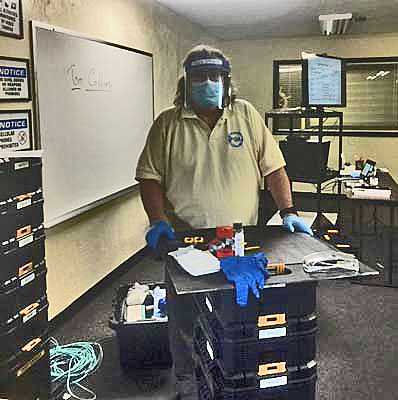
Instructor Tom Collins perpared to teach in the classroom.
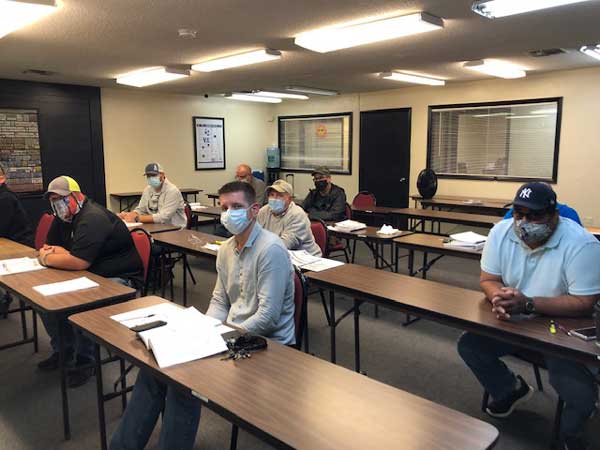
Students with appropriate distancing.
Training
Is Back - Made Safer (6/2020)
FOA
schools are starting to offer classes at their facilities
again to provide the personal interaction with an instructor
and hands-on labs, but some things have changed to provide
social distancing. Serge Rodrigue at Fibre
Zone in Quebec, Canada sent photos of his new lab
setup that includes individual lab stations with plexiglass
barriers. 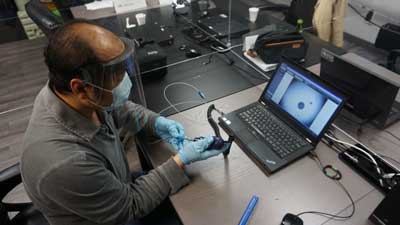
Students are following safe working protocols - masks and gloves - to make classes safe and meet local government requirements for social distancing.
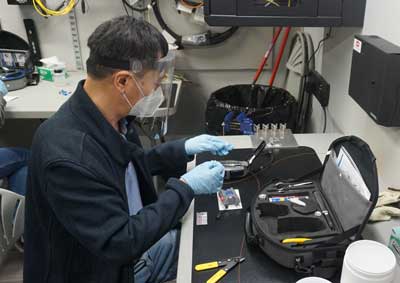
Contact Fibre Zone in Quebec, Canada for more information on their classes.
FiberNext in New Hampshire has also rearranged classrooms for safer classes and has begun training in their facilities in Concord, NH.
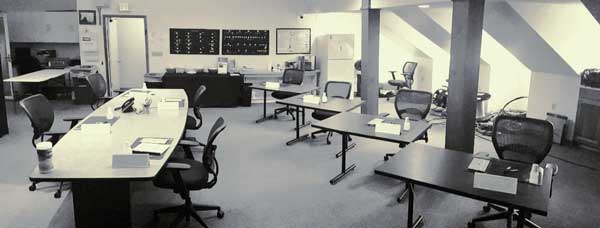
Contact FiberNext in Concord, NH, USA or more information on their classes. Also ask about joining their CFOT Club for savings on products and training.
DIY (Do-It-Yourself) Labs (6/20)
Knowledge is easy to get online, but learning skills requires "hands-on" practice and that requires tools and components to practice with. Here at FOA, we've been working on an online course that could help many techs learn new skills or improve others using an online self-study course and their own equipment. Recently, we have updated the materials in the Fiber U Fiber Optics Basic Skills Labs which includes cable preparation, splicing, termination and testing. And we have created a Basic Skills Labs - Copper Premises Cabling to cover UTP (Cat 5) and coax copper cable processes. As with all Fiber U courses, these are free.
Several times in the FOA Newsletter we've discussed the Fiber U Basic Skills Lab. This online DIY lab course assumes you have your own equipment to use for the labs, but most novices, unless they work for a larger company already in fiber optics, will not have equipment. FOA instructors have found a solution: purchase inexpensive equipment online. What they have found are many low cost tools and components that are perfectly suited to training.
If you do not have tools or equipment and want to purchase them, there is a new Fiber U DIY Basic Skills Lab lesson with directions on how to purchase inexpensive tools online and use them to learn basic fiber optic skills. Those tools and components are what we describe here.
For example, you need a fiber cleaver for splices and prepolished/splice connectors. A good cleave is essential for a good splice or termination with a splice-type connection. Good cleavers are now available online at prices in the US starting at $20US.
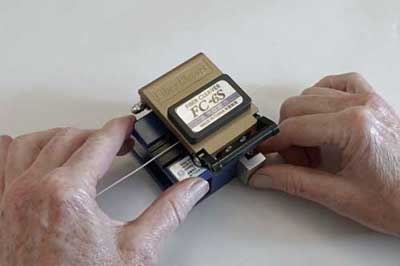
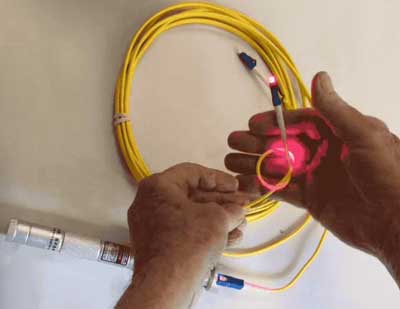
Besides the cleaver, another really good tool for learning or teaching is a visual fault locator. These devices used to be very expensive, but now are available online for $10-20.
Many online sellers offer sets of fiber optic tools in a kit for very low cost.
With plenty of tools available online, the next things you need are components to practice on. No problem here either. You need a patchcord, some mechanical splices and some prepolished/splice connectors. The connectors and splices are available from online sellers for ~$1 each, easy to afford plenty to practice on.
FOA has used all these available parts together into a do-it-yourself hands-on lab as part of the Fiber U Basic Skills Lab. You can do this yourself at a very low cost. We even provide directions on how to search for suppliers of these tools and components.
Caution!
FOA has not exhaustively tested these tools or components enough to recommend them for field use. The work we did with them to create teaching labs shows they are certainly good enough to use for teaching the installation processes in a training lab. We suggest read the buyers reviews and do some of your own testing before using them for anything other than training and practice.
FOA
Guide "Basics Of Fiber Optics" Now Available Online in
Portuguese (6/2020)
FOA has
now translated the Basics of Fiber Optics textbook in our
Online Guide into Portuguese, joining Spanish and French
translations. For those speaking Portuguese, we have the
technical information and for schools we also have
curriculum available. Here is the FOA Guide in Portuguese, Spanish and French translations.
Time
To Learn - Online - (Update 4/5/6/8 2020)
Schools
have generally been closed during the pandemic lock-downs,
so FOA has been working with some of them to create new
online learning experiences that can in some cases lead to
certification online. FOA certifications are still based on
the KSAs - knowledge from the classroom, skills from the
labs and abilities judged by instructors or proven by actual
experience. ZOOMing
Much of what we're doing benefits from the capabilities of "Zoom." Others have created videoconferencing apps, but none work so well, especially with limited bandwidth. We've seen remote labs that have an instructor showing students how to use the tools they were sent then watching them duplicate their actions. We have worked out methods to use Zoom to proctor FOA's online certification exams.
Blended Learning
While most FOA schools have suspended in-person training during this period, some are offering a "blended learning" option. That means that students sign up for a FOA certification course, take the classroom sessions on Fiber U with the assistance of a FOA certified instructor. Now online instruction can include reviewing the labs using the Fiber U Basic Skills Labs, then when it's possible to attend classes at the school, complete the hands-on labs and take the FOA certification exam.
Online Remote Labs
Alternatively, some schools are experimenting with "remote labs," where the students get sent tool kits and components and labs are conducted by videoconferencing. Before the labs, the students may watch demos by their instructor on videoconferencing and/or review the relevant "virtual hands-on" lessons in the Fiber U Fiber Optics Basic Skills Labs so they will already know the steps in the exercises. And Fiber U has the new Fiber U DIY Basic Skills Lab lesson with directions on how to purchase inexpensive tools online and use them to learn basic fiber optic skills. Videoconferencing allows the instructor to remotely monitor their work and provide help as needed. Contact the FOA for more information.
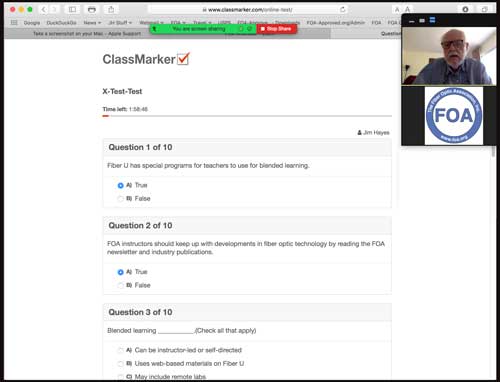
FOA Zoom Exam Proctoring
Online Certification Testing
FOA has all its certification tests available online, both for use by our schools and by our direct "Work to Cert" applicants. All FOA certification tests require a proctor to oversee the applicant taking the exam. In this time of social distancing, getting a proctor can be difficult, so FOA now has procedures for online proctors administering the exam. Contact the FOA for more information.
OJT - On-The-Job-Training
Many novices get a job and learn on the job. They usually have an experienced tech who helps them gain the knowledge and learn the skills they need to perform their job. Thinking about this in relation to the FOA KSAs, the knowledge, skills and abilities needed by a fiber optic tech, the tech will learn skills but not the basic knowledge that helps them understand the processes involved. FOA can offer help here, using our Fiber U online self-study programs. While the tech learns on the job, they become a Fiber U trainee, getting the knowledge they need, while working under their "mentor" at work. This is particularly good for contracting companies who need techs but do not have the usual training courses available. Interested in OJT programs? Contact FOA for more information.
Can You Learn Hands-On Skills Online?

Knowledge is easy to learn online, but learning skills requires "hands-on" practice and that requires tools and components to practice with. Here at FOA, we've been working on an online course that could help many techs learn new skills or improve others using an online self-study course and their own equipment. Recently, we have updated the materials in the Fiber U Fiber Optics Basic Skills Labs which includes cable preparation, splicing, termination and testing. And we have created a Basic Skills Labs - Copper Premises Cabling to cover UTP (Cat 5) and coax copper cable processes. As with all Fiber U courses, these are free.

FOA offers free online self-study programs at Fiber U. Many users are preparing for FOA certification programs - taking courses at our schools or using the "Work-to-Cert" program. Some of our schools are requiring Fiber U programs as prerequisites for their classroom courses so they can spend more time on hands-on activities.
New
FOA Approved School: Central
Electrical Training Center, FOA
School #656.
FOA School Offers Toolkit With Online Training
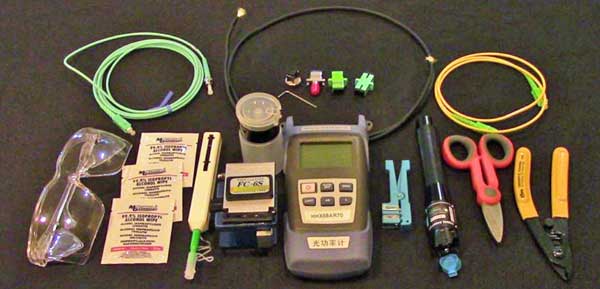
Slayton Solutions (FOA Approved School #156) is offering a simple fiber optic tool kit that includes a 29-piece set of fiber optic tools and a power meter along with training videos and online instruction for only $499. 29 Piece Kit includes all tools and devices a technician needs to install fiber optic connectors and test optical power. Information on the kit is available on YouTube. You can contact them for more information at slaytonsolutions@sbcglobal.net or https://www.fiberopticsinstitute.com
Publications / Resources
More
New FOA Video Lectures On YouTube
As part
of developing the new Fiber U MiniCourses, we added several
new YouTube videos: Lecture 56 explains the issues of cable bend radius limitations, typical cable specifications and how to gage the proper radius or diameter when installing or storing cable. Lecture 57 covers problems with dirty connectors and how to inspect and clean them.
Videos added last month:
FOA Lecture 51 Fiber Optic Restoration Part 1 - Causes of Damage To The Network
FOA Lecture 52 Fiber Optic Restoration Part 2 - Planning For Restoration
FOA Lecture 53 Fiber Optic Restoration Part 3 - Troubleshooting And Repair
FOA Lecture 54 Fiber Optic Connector Identification - New and old
FOA Lecture 55 The Mysterious dB of Fiber Optics. - Understanding dB
FOA Lecture 56 Fiber Optic Cable - Bend Radius - Important for Installers to Understand
Lectures 51, 52 and 53 are about fiber optic network restoration, broken into 3 parts: what causes damage, how to plan for restoration and finally troubleshooting and repairing a network outage. Lecture 54 is a short history of the development of fiber optic connectors and a overview of the ones most used today. Lecture 55 will teach you about dB, it's origin, an explanation of the math behind it and why standards can make it confusing. Lecture 56 explains fiber optic cable bend radius limits and reduces the confusion over radius and diameter. Lecture 57 is a quick tutorial on cleaning and inspecting connectors. Lecture 58 is about converting fiber to copper or multimode to singlemode fiber.
Like all our YouTube lectures, they are all short and easy to understand.
FOA
Loss Budget Calculator On A Web Page 5/2020
FOA has written many articles about loss budgets, something everyone involved in fiber optics needs to know and needs to know how to calculate. We recently discovered how to get a spreadsheet ported to a Web page, so we created this web page that calculates loss budgets. We have an iOS loss budget app, but with this web page, you can calculate loss budgets from any device, smart phone, tablet, laptop, or desktop computer that has web browsing capability.

Bookmark this page (especially on your smartphone): FOA Loss Budget Calculator Online
 We are
continually updating the Online Reference Guide to keep up
with changes in the industry and adding lots of new pages of
technical information. When you go to the FOA
Guide Table of Contents to see the latest updates -
look for
We are
continually updating the Online Reference Guide to keep up
with changes in the industry and adding lots of new pages of
technical information. When you go to the FOA
Guide Table of Contents to see the latest updates -
look for  .
.Recent updates:
10GPON on PON Protocols in the FOA Guide.
Coherent Communications Systems in the FOA Guide.
Updated (and more illustrations): Basic Fiber Optic Jargon, OSP Fiber Optic Jargon and Fiber Optic Jargon for managers.
Fiber Optic Network Restoration
Fiber Characterization goes in to more depth, why fiber characterization is important and how to interpret results.
Fiber Optic Network Management for managers
FOA has created a section on OSP Construction and a Fiber U course based on it.
FOA Guide section on inspecting and cleaning connectors.
Go to The FOA Online Fiber Optic Reference Guide.
FOA Reference Books
Available Printed or Kindle Books
The fiber book is available in Spanish and French (printed) and Portuguese (online). The design book is available in Spanish (online)








FOA has reprinted "Lennie Lightwave's Guide" on its 25th anniversary in a special print edition.
Lennie and Uncle Ted's Guides are online or as free iBooks on iTunes.


Click on any of the books to learn more.
- Fiber Optic Safety Poster to download and print
Resources For Teachers In K-12 And Technical Schools
Teachers in all grades can introduce their students to fiber optic technology with some simple demonstrations. FOA has created a page for STEM or STEAM (science, technology, engineering, arts and math) teachers with materials appropriate to their classes. Fiber Optic Resources For Teachers.
Safety
On Safety
FOA considers safety an integral part of all our programs, curriculum materials and technical materials. We start all our textbooks and their online versions with a section on safety in the first chapter, like this: Before we get started - Safety First!There are pages on the FOA Guide on Safety procedures Including Eye Safety and. Digging Safely
And a YouTube lecture: FOA Lecture 2: Safety When Working With Fiber Optics
In our OSP Construction Section, these pages cover many safety issues including those related to the construction of the cable plant: Project Preparation And Guidelines, Underground Cable Construction, Underground Cable Installation and Aerial Cable Installation.
There is even a safety poster for the fiber activities: PDF Safety Rules For Fiber Optics
The FOA is concerned about safety!
There is a toll-free "call before you dig" number in the USA: Dial 811
See www.call811.com for more information
The
Common Ground Alliance has an excellent "Best
Practices Guide" online
- The US Department of Transportation has a website called "National Pipeline Mapping System" that allows one to search for buried pipelines.
Why We Warn You To Be Careful About Fiber Shards
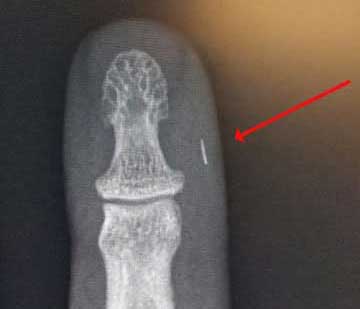
Photo courtesy Brian Brandstetter, Mississauga Training Consultantcy
Safety Leader Magazine
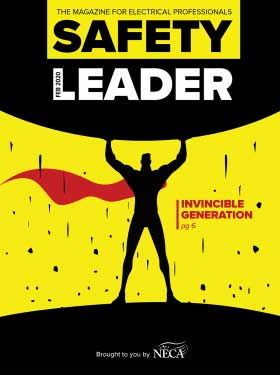
Safety Leader, a new quarterly magazine, informs and educates electrical contractors on safety from various angles—electrical, workplace, PPE, regulations, leadership, line work, NFPA 70E, and more. Safety Leader is bundled with ELECTRICAL CONTRACTOR in February, May, August and November. To receive Safety Leader subscribe to ELECTRICAL CONTRACTOR magazine here or subscribe to the ELECTRICAL CONTRACTOR newsletter here.
2021 Conference On Damage Prevention Goes Virtual

2021 Global Excavation Safety Conference VIRTUAL, taking place April 6-8, 2021
More information in an article in the dp-PRO announcing the Global Locate Masters:
Website: www.GlobalLocateMasters.com
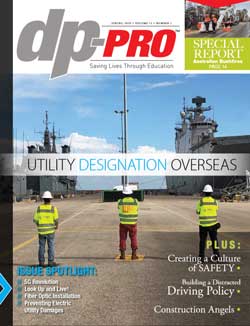
The magazine, dp-Pro, sponsor of the conference, has also published it's latest issue with an article by FOA on "New Construction Techniques in Fiber Optics" and a overview of the FOA. You can read the magazine here.
Best Practices Guide For Underground Construction
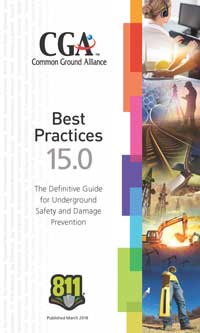
We assume you are familiar with the "One Call" and "Call Before You Dig" (811) program, but are you also familiar "Click Before You Dig.com" and with the people behind it - the Common Ground Alliance and their Best Practices website?
Officially formed in 2000, the CGA represents a continuation of the damage prevention efforts embodied by the Common Ground Study. Sponsored by the U.S. Department of Transportation and completed in 1999, this Study represents the collaborative work of 160 industry professionals who identified best practices relating to damage prevention. Any best practice or program endorsed by the CGA comes with consensus support from experts representing the following stakeholder groups: Excavators, Locators, Road Builders, Electric, Telecommunications, Oil, Gas Distribution, Gas Transmission, Railroad, One Call, Public Works, Equipment Manufacturing, State Regulators, Insurance, Emergency Services and Engineering/Design.
Read the CGA Best Practices Guide here.
Here are all the CGA resources for damage prevention.
The US Department of Transportation has a website called "National Pipeline Mapping System" that allows one to search for buried pipelines.
FOA/About
About The FOA
- Contact
Us: http://www.foa.org
or email <info@foa.org>
FOA has a company page and four LinkedIn Groups
FOA - official company page on LinkedIn
FOA - covers FOA, technology and jobs in the fiber optic marketplace
FOA Fiber Optic Training - open to all, covers fiber optic technology and training topics
Grupo de La Asociación de Fibra Óptica FOA (Español)
What is The FOA?
The FOA is a, international non-profit educational association chartered to promote professionalism in fiber optics through education, certification and standards.
Founded in 1995 by a dozen prominent fiber optics trainers and leaders from education, industry and government as a professional society for fiber optics and a source of independent certification, the FOA has grown to now being involved in numerous activities to educate the world about fiber optics and certify the workers who design, build and operate the world's fiber optic networks.
FOA
is 25 years old this July - read about FOA's history in
this newsletter above.
Learn More About FOA's History.
Contact Us
The Fiber Optic Association Inc.
http://www.foa.org or email <info@foa.org>
The FOA Home Page

Want to know more about fiber optics? Study for FOA certifications? Free Self-Study Programs are on "Fiber U®." Looking for specific information? Here's the largest technical reference on the web: The FOA Online Fiber Optic Reference Guide.

Free online self-study programs on many fiber optics and cabling topics are available at Fiber U, FOA's online web-based training website.
-
Contact Us
The Fiber Optic Association Inc.
http://www.foa.org or email <info@foa.org> - Phone:
1-760-451-3655
(C)1999-2020, The Fiber Optic Association, Inc.
FOA Logo Merchandise
-
New
FOA Swag! Shirts, Caps, Stickers, Cups, etc.
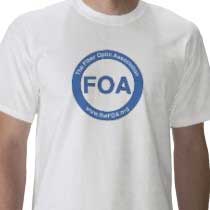
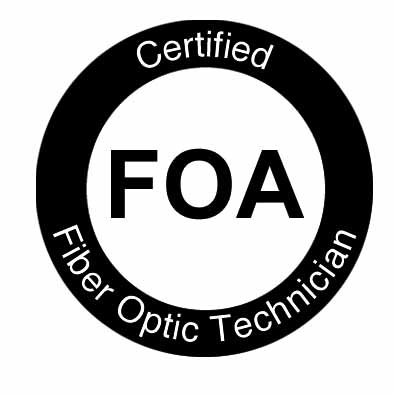
Your Name, CFOT® - It pays to advertise!
The FOA encourages CFOTs to use the logo on their business cards, letterhead, truck or van, etc. and provides logo files for that purpose. But we are also asked about how to use the CFOT or CFOS certifications. Easy, you can refer to yourself as "Your Name, CFOT" or "Your Name, CFOS/T" for example.
Feel free to use the logo and designations to promote your achievements and professionalism!
Contact FOA at info@thefoa.org to get logos in file format for your use.Privacy
Policy (for the EU
GDPR): The FOA does not use cookies or any other
web tricks to gather information on visitors to our
website, nor do we allow commercial advertising. Our
website hosts may gather traffic statistics for the
visitors to our website and our online testing service,
ClassMarker, maintains statistics of test results. We do
not release or misuse any information on any of our
members except we will confirm FOA certifications and
Fiber U certificates of completion when requested by
appropriate persons such as employers or personnel
services.
Read
the complete FOA Privacy Policy here.




